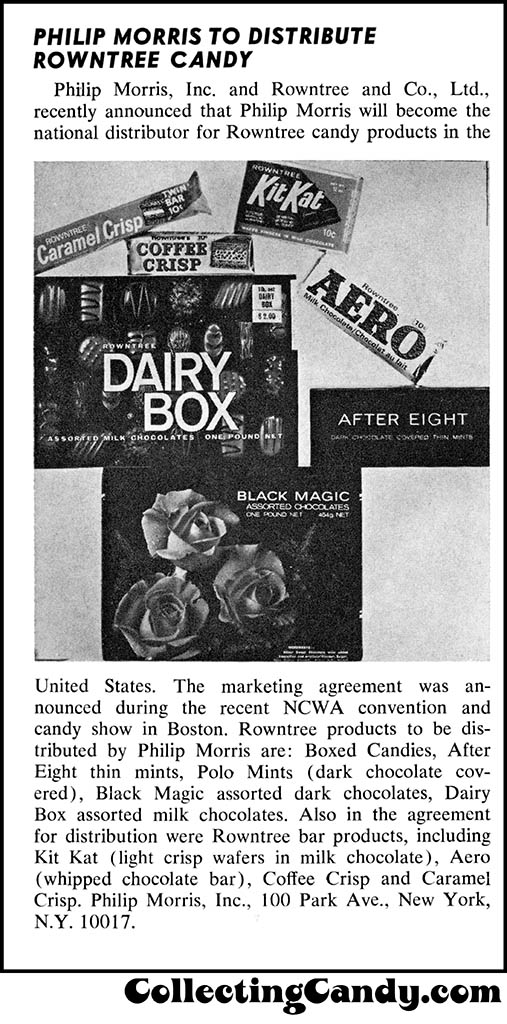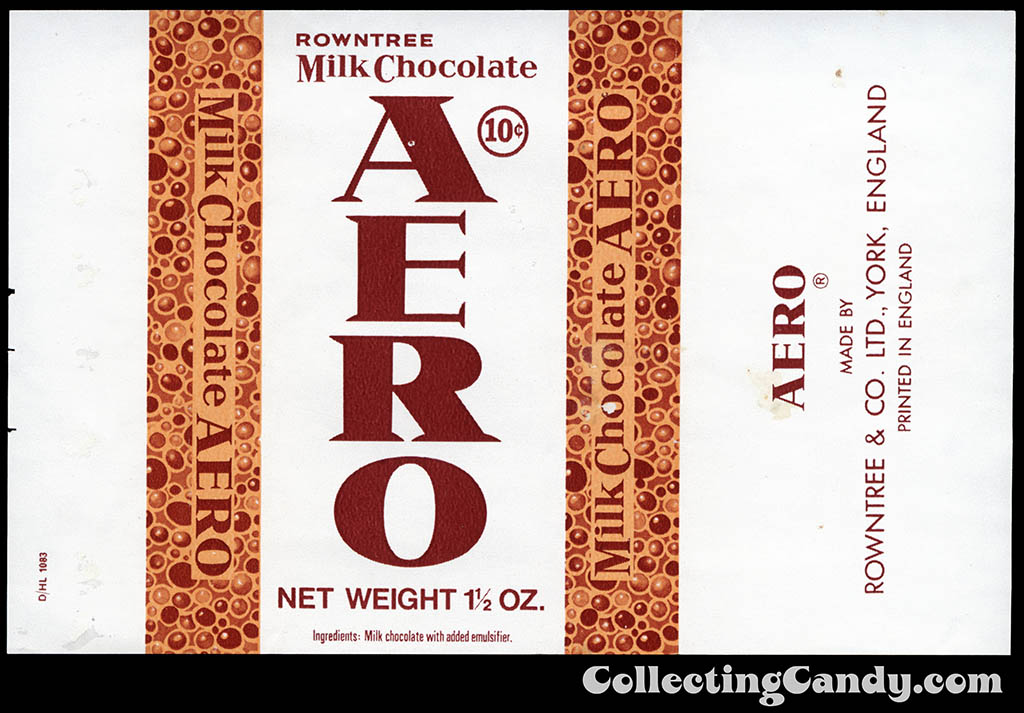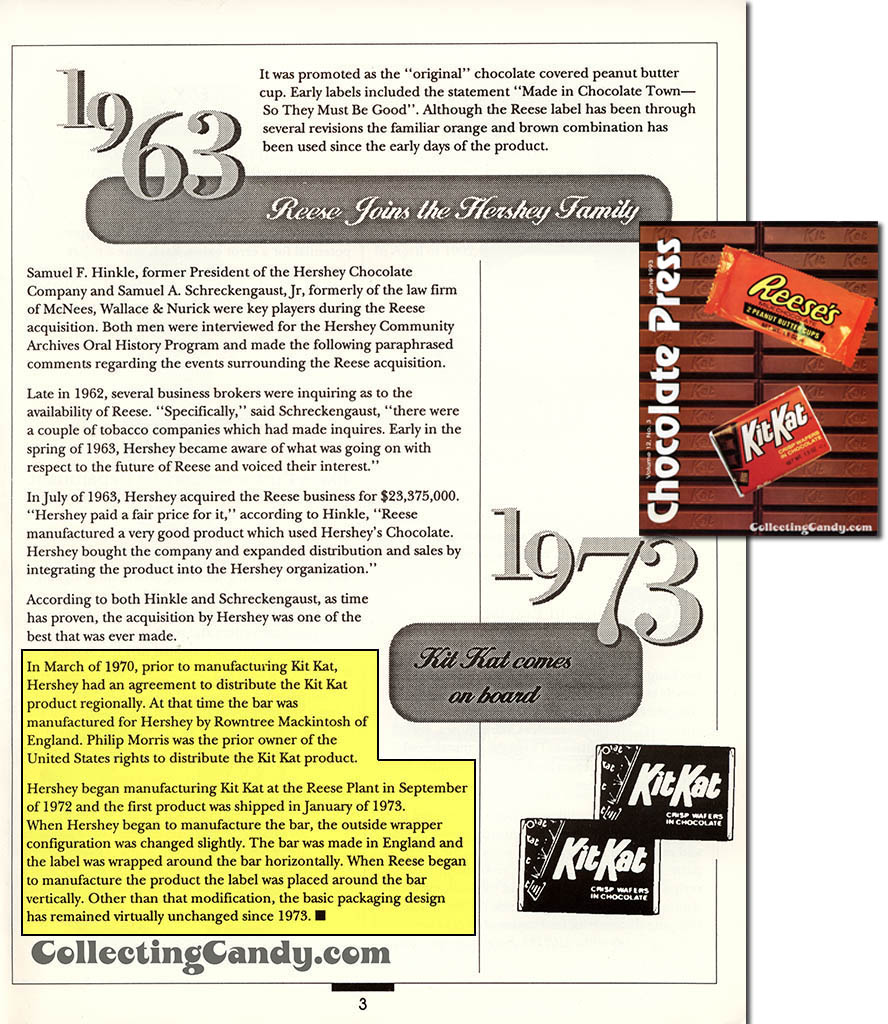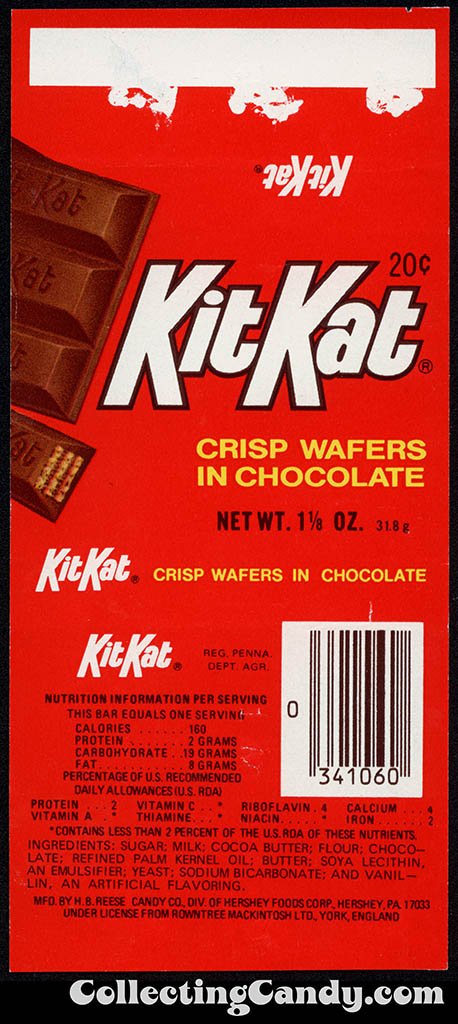
Kit Kat’s earliest days are well-recorded. Created in the United Kingdom by the Rowntree company all the way back in 1935 as Rowntree’s Chocolate Crisp (officially branded as Kit Kat in 1937), it would eventually grow to become a worldwide confectionery phenomenon – one of the undisputed all-time great brands. Yet the story of Kit Kat in the United States (before its acquisition by Hershey in the early 1970’s) has long been shrouded in mystery, and it’s a tale I’ve spent years working to uncover.
Recently I made an exciting discovery that clarifies a big part in the pre-Hershey history of Kit Kat in the USA. Make the jump to check it out!
Before I get to unveiling the details of my recent Kit Kat discovery, I thought it would be helpful to lay the table by explaining how the Kit Kat brand is currently distributed worldwide, and how it got there.
As I already mentioned, the Rowntree company of England sold its first branded Kit Kat back in 1937. I’m fortunate to have one of these early Kit Kat wrappers in my collection:

UK – Rowntrees Kit Kat Chocolate Crisp – the very first Kit Kat – 2d chocolate candy wrapper – 1937
That same year, another UK chocolate manufacturer called John Mackintosh and Co. released its own classic, the Rolo. After years of competition, the Rowntree and Mackintosh companies would merge in 1969 to form Rowntree-Mackintosh – an effort which helped both companies expand their brands globally. Around this same time, Rowntree would make efforts to license the distribution of several of its products to solidify its reach into the United States (more on this later). Nearly two decades later in 1988, Nestle would acquire Rowntree-Mackintosh and all its assorted brands including long-time favorites like Kit Kat, Rolo and Aero.
During Rowntree’s decades of growing the Kit Kat brand and before they would merge with Mackintosh, they would make efforts to get Kit Kat onto United States’ store shelves. This earliest part of Kit Kat USA’s story is still hazy but I do know that at some point in the 1950’s or 1960’s Rowntree distributed the Kit Kat to stores here, as I have a wrapper from this effort. Here’s an example of one of those earliest USA Kit Kat wrappers [Note the awesome Rowntree logo design on the back.]:

USA – Rowntree – KitKat – Kit Kat – 10-cent candy bar wrapper – 1950’s 1960’s
In the 1960’s, Rowntree had a New York office to handle their moves into the USA marketplace, but in 1968 they changed strategies by enlisting Phillip-Morris to handle all of their distribution in the United States. That change included more than just the Kit Kat, as is documented in this 1968 trade clipping:

Phillip Morris Rowntree trade clipping – September 1968
[Note: For those that aren’t aware, Phillip-Morris is best known as the parent company of some of the largest cigarette/tobacco brands in the world. If you’re wondering why a cigarette company might be a good place for a candy manufacturer to seek distribution with, it is the fact that in the 1960’s most candy and cigarettes were sold at mom and pop stores, and in many cases distributed and sold by the same wholesalers and salesman/jobbers. Phillip-Morris already had the distribution network that Rowntree was seeking to get into.]
That 1968 trade clipping is something I’d had but been overlooking for the past few years, not realizing its significance in the history of the Kit Kat brand here in the USA. That finally changed last month.
Recently I acquired a group of (mostly American) candy wrappers from the late 1960’s and early 1970’s. Among them were what I initially thought were a pair of Canadian Kit Kat and Aero bar wrappers. I made that initial assumption based on the Kit Kat wrapper design and the fact that the Aero bar wasn’t, to my knowledge, sold in the US at the time.
But as I looked closer I realized I was wrong and that I had uncovered something far more remarkable – this was a USA Rowntree Kit Kat wrapper from the years just before Hershey began manufacturing them for the United States region! This is the amazing wrapper in question:

Rowntree – Kit Kat – UK-produced for USA distribution – 10-cent 1 1/4 oz chocolate bar wrapper – late 1960’s to early 1970’s
Not only that, but I learned that the Aero bar was briefly sold in the USA two decades before I thought it ever was.

Rowntree – Aero – UK produced for USA distribution – 10-cent 1 1/2 oz chocolate bar wrapper – late 1960’s to early 1970’s
So, after years of wondering what the USA Kit Kat might have looked like in those lost and unknown years between its first release and the mid-70’s Hershey version, the mystery was finally solved.
But there’s still a bit of mystery to this Kit Kat wrapper and here it is: It’s possible that this 10-cent USA Rowntree Kit Kat wrapper is one that was distributed by Rowntree’s own United States branch in the mid-to-late 1960’s, or it could have been sold under the Phillip-Morris distribution deal in 1968-69. But there’s even the possibility that this wrapper went unchanged and kept the Rowntree name even when Kit Kat was initially distributed by Hershey from 1970-72. It’s difficult to know for certain without further evidence and corroboration. The fact that both Phillip-Morris AND Hershey had short-term distribution deals with Rowntree that didn’t include a hand in manufacturing makes any of the three scenarios possible. Which brings me to my next discovery.
Uncovering this Kit Kat wrapper prompted me to dig through my archives for a June 1993 Hershey Chocolate Press employee newsletter; it was one that I recalled had mentioned the original Hershey Kit Kat distribution deal. The newsletter explains that Hershey took over the US distribution of Kit Kat (from Phillip-Morris) in 1970, yet didn’t start manufacturing them domestically until a few years later in 1973.

Hershey’s Chocolate Press – employee newsletter – June 1993 – Page 3 – Kit Kat comes on board
It’s quite possible that Hershey was using the Rowntree wrapper printed for US markets while they were importing the UK-manufactured Kit Kat bars. By 1973, this would change and Hershey would introduce a USA Kit Kat wrapper design that would go largely unchanged for the next two decades. Here’s an early one from 1977:

CC_Hershey – Kit Kat – 20-cent chocolate candy wrapper – 1977
It’s worth noting that, …“in 1978 the Hershey contract was renegotiated, giving Hershey the rights to the Kit Kat and Rolo brands in the US in perpetuity.” [Note: Boston-based NECCO had previously been the Rolo licensee and distributor in the United States.] This permanent licensing agreement has turned into one of the best deals ever made for Hershey or any company, which has exclusively manufactured and distributed the Kit Kat and Rolo brands for USA markets ever since.
And that’s everything I’ve got to share on my new discoveries and insights into Kit Kat’s pre-Hershey history. I hope you dig it and I’ll see you next time!
P.S. I covered this discovery in a recent episode of TheCandyGeek vlog which you can check out here:




Very interesting stuff, Jas. Congrats for getting those wrappers, they’re really cool!
I was very confused over when the Rolo and KitKat license with Hershey started as there is a lot of conflicting information out there so thank you so much for clearing this all up!
So, the contract is in perpetuity – that must make Nestle rather annoyed – the only way they can get their brands back is to buy them and Hershey would need to be willing to sell – a snowflake in hell’s chance I think!
A very similar situation with Cadbury – it must also annoy Mondelez that they don’t have control over the brand in the USA. I erroneously thought the 1988 contract was for 25 years, however 2013 has come and gone and Cadbury is still with Hershey – perhaps that’s one you might look into as well?
A couple of other things – specifically about the trade press cutting from 1968:
(1) “Caramel Crisp” – what the heck is that? I don’t remember that from my childhood in England and have not seen it anywhere else – perhaps it was dropped before I was around. “Toffee Crisp” yes – however that was a Mackintosh product. I always thought that Toffee Crisp should’ve been called Caramel Crisp as what’s in it is too gooey to be called toffee. Perhaps Mackintosh couldn’t call it Caramel Crisp because Rowntree already owned that name.
(2) “Polo Mints (Dark Chocolate covered)” – Polo mints are the UK version of Life Saver mints and so are hard candy – I’ve never seen them chocolate covered so perhaps this was a special US-only version (since the original was identical to something that was already well established).
Again many thanks for your research!
From what I can attain Matty, the milk chocolate, twin bar ‘Caramel Crisp’ and the milk chocolate, single bar ‘Coffee Crisp’, were manufactured under the name of Roundtree for the US market only. You are right that in the UK, probably from the same factory, an identical bar was produced for the UK market but called, ‘Toffee Crisp’ under the name of Mackintosh. But unlike the US, the UK bars came in orange wrappers for the milk chocolate and blue wrappers for the plain chocolate version.
As for the name ‘Polo Mint’ appearing in the advert, my guess it was a printing press error. No chocolate Polo mint was ever made. If you disregard this, in brackets it is describing the After Eight thin mints as being dark chocolate covered.
Life Savers were first invented by an American chocolate manufacturer, Clarence Crane in 1912. The hole in the middle was and error for the mint, but it left it looking distinctive. So he decided to call them ‘Life Savers’ as the shape resembled a life saving belt. They were eventually produced in the UK too in early 1920’s. It wasn’t until 1939 that Roundtree copied the idea and called them Polo Mints. Spangles, a square boiled sweet from Mars tried to compete in the early 70’s with a square mint with a hole, but never caught on and was short lived.
Great post! I really learned a lot.
As a graphic designer, I find it beyond interesting that the Kit Kat logo has remained nearly the same since 1937! Wow, now that’s good branding surviving the test of time.
Pingback: My Year in Collecting: 2015! | CollectingCandy.com
I can tell you this. Areo candy, which I recall was similar in taste to the Kit Kat bar was sold in Ohio at Woolworth up until the early 1960’s. Then one day it was gone and in its place was the Kit Kat brand. Being 8 years old and know I would spend my adult career in something called “marketing” I was not happy as I feel Kit Kat was an inferior product as to the quality of candy. But I recall Areo bars as also having the graham cracker filling. That my memory and can quarantee Areo bars were sold in the U.S. at that time.
Makes sense that it’s an American wrapper, and not Canadian, because it says “Reg. Penna Dept. Agr” which means “Registered witg the Pennsylvania Department of Agriculture”.
So, yeah, that HAD to have been one of the Phillip Morris-licensed U.S. Kit Kat wrappers, and not a Canadian wrapper.
By the way, is Phillip Morris the same company that owns Marlboro cigarettes? I think it is.
Speaking of, after a long day at work, cigarettes and a martini relieve stress.
And anyway, Kit Kats are still made, but can you still get Aero bars?
I ate an Aero bar decades ago, and I have a co-worker/friend who ate an Aero bar and drank Tang (that orange fruit drink) while watching the moon landing in living color on NBC. That would’ve been the late 60s.
Growing up in Britain during the 60’s, I could buy the Roundtree’s KitKat for 6d. This was equivalent to 4¢. But they were retailed at this time to the US for 10¢. Of course having to be imported from the UK will incur duty taxes etc; which would push up the price for the US retailer. Once production began in the US, in reality production costs would substantially drop. But I suppose this is where company greed steps in with the notion that if the consumer in the US was happy to pay 10¢, it can stay. Especially as just a mere 10 years on they had risen to 20¢. This practise never seems to change. I’ve been living in rural China for 17 years and any goods I am used to were eventually imported here, but well over priced. In time, under licence these same goods are today manufactured in China for their domestic market, but still over priced and retail three times more than in the UK. Consequently, the Chinese won’t buy them as they’re too expensive and just pick them up on my next visit. But overall, thanks for a great and interesting piece of history… Now I’ll , “Have a break…”